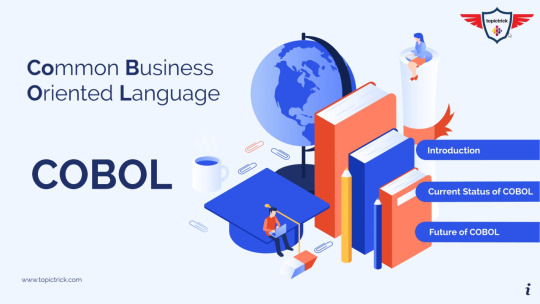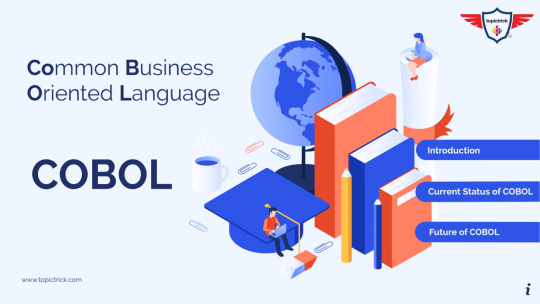#COBOLprogramming
Explore tagged Tumblr posts
Text
COBOL Tutorial - COBOL Programming Tutorial. Free Curso de COBOL 60+

COBOL is one of the oldest programming languages. It's still in use and is growing at a constant rate. The COBOL programming tutorial, give a brief overview of the COBOL, and its history. It also outlines the characteristics, usage, various functions, and popularity. This programming tutorial has multiple section and each section is associated with youtube tutorial video along with precise description of the topic. In the last section, you'll know why COBOL still dominate enterprise computing. Let's begin our COBOL programming tutorial with Introduction to COBOL. Table of Contents Introduction to COBOL Common Business-Oriented Language The COBOL is a short form of Common Business-Oriented Language. It is a high-level programming language and used to develop business-oriented applications. COBOL is one of the oldest and extensively used programming languages. COBOL has always maintained a low profile. But dominates enterprise computing for the last 60 years. You'll be surprised to know that COBOL is still growing at a constant pace. COBOL is a robust, powerful, easy to learn, and simple to design complex enterprise application. It offers excellent file handling, database handling, reporting, sorting, and merging capability. In fact, you can design the front-end applications with COBOL. What is COBOL? Common Business-Oriented Language Common Business Oriented Language is a full form of COBOL. Read the full article
0 notes
Text
COBOL Tutorial - COBOL Programming Tutorial. Free Curso de COBOL 60+

COBOL is one of the oldest programming languages. It's still in use and is growing at a constant rate. The COBOL programming tutorial gives a brief overview of the COBOL and its history. It also outlines the characteristics, usage, various functions, and popularity. This programming tutorial has multiple sections and each section is associated with a youtube tutorial video along with a precise description of the topic. In the last section, you'll know why COBOL still dominates enterprise computing. Let's begin our COBOL programming tutorial with Introduction to COBOL.
Introduction to COBOL
Common Business-Oriented Language The COBOL is a short form of Common Business-Oriented Language. It is a high-level programming language and used to develop business-oriented applications. COBOL is one of the oldest and extensively used programming languages. COBOL has always maintained a low profile. But dominates enterprise computing for the last 60 years. You'll be surprised to know that COBOL is still growing at a constant pace. COBOL is a robust, powerful, easy to learn, and simple to design complex enterprise application. It offers excellent file handling, database handling, reporting, sorting, and merging capability. In fact, you can design the front-end applications with COBOL.
What is COBOL?
Common Business-Oriented Language Common Business Oriented Language is a full form of COBOL. A high-level programming language developed in the 1960s and It's still in demand due to its power in handling the data processing needs of the business. As the name suggests, it is not a general-purpose programming language such as Java, Python, C++, etc. It focuses on enterprise computing or specific business. It's used for building a large-scale, long-lasting, data-oriented, centralized, and mission-critical application. COBOL is powerful and reliable in processing transaction data. It is still the preferred language because there are more than a billion lines of COBOL code running in the production. There are thousands of application that serve billions of customer request daily. Each one of us use the COBOL application daily either directly or indirectly. You'll find COBOL code in almost all domain applications such as Banking, Insurance, Government, Railway, Telecom, Retails, and many more, you keep on counting. Last but not the least, COBOL is stilling running the show.
History of COBOL.
Common Business-Oriented Language Now, let's explore the history of the oldest programming language. The inventor of COBOL actually wants to develop a language that is robust, simple, powerful, dependable and English-like programming Language. The journey of COBOL begins in the year 1950 when the world senses the need for programming language. In May 1958, U.S. Dept of Defence holds a conference to bring a group of the engineer from different fields to develop high-level programming language. The team of professionals is named CODASYL (Conference On Data Systems Language). The new language comes into existence in 1959 and was released in 1960 as COBOL. The major milestone in the history of COBOL is 1968 when American National Standards (ANSI) approved for commercial use. The major milestone in the history of COBOL is 1968 when American National Standards (ANSI) approved for commercial use. Since 1968 COBOL is evolving with tons of new features such as object-oriented programming, XML, JSON data support. COBOL becomes powerful and versatile with every new release. But it has always kept the old syntax unchanged. So, you are not required to upgrade yourself, learn once, and use it forever. Following is a pictorial representation of the History of COBOL.

History Of COBOL - Common Business Oriented Language.
Features of COBOL.
Common Business-Oriented Language. Almost 70% of people use COBOL applications while traveling/ withdrawing money from ATMs, etc. COBOL is one of the oldest programming languages and it's still used heavily in various sectors such as banking and financial services, aviation industry, retail industry, automobile industry, etc. COBOL is a Business-Oriented language with simple and powerful architecture. Following are the feature of the COBOL Programming language. - COBOL is a standard language. - COBOL is platform-independent. - COBOL is an English-like programming language. - COBOL is a structured programming language. - COBOL also supports object-oriented programming. - COBOL has excellent file handling and database handling capabilities. COBOL Introduction and It's Dominates In Enterprise Computing. COBOL has always maintained a low profile and it has a 60-year proven track record for application production, maintenance, and enhancement. In this video, you'll learn why COBOL is still used in most enterprise application and what would be the future of COBOL. https://youtu.be/YU8GQF4n3Kc
COBOL PROGRAM STRUCTURE Overview
Common Business-Oriented Language The COBOL program structure is very simple and easy to understand. Each COBOL program is divided into four divisions. Following are the divisions: - IDENTIFICATION DIVISION - ENVIRONMENT DIVISION - DATA DIVISION. - PROCEDURE DIVISION. These divisions are further divided into sub-divisions. Also, the most basic unit of the COBOL language is the character, a group of characters form words, and a group of words forms statements. A group of statement form paragraph and paragraph can be grouped into the section. Finally, the section is grouped into PROCEDURE DIVISION. COBOL Program Structure Overview. COBOL program structure is fairly simple and easy to understand. In this video you'll learn about the various division of a COBOL program. Also, you'll learn what are the sub-division of each section and what is the significance of each sections. https://youtu.be/yZePB3jA9Dc
COBOL DATA TYPES
Common Business-Oriented Language In laymen's term, a data type is an attribute of data which tell the compiler or interpreter how the programmer intends to use the data. n COBOL, there are only three types of data types: Numeric, Alphanumeric (text/string), and Alphabetic. Edited Numeric and Edited Alphanumeric are two subcategories of data types used for reporting. Variable: A variable is a data item; its value can change during a program. The values are restricted, however, to the data type that you define when you give the variable a name and a length. 01 Customer-Name Pic X(20). Literals: Literal is a character string whose value is given by the characters themselves. MOVE “MURPHY” TO Customer-Name Constants: A constant is a data item that has only one value. COBOL does not define a construct specifically for constants. 01 Interest PIC 9(02) VALUE 10. COBOL Data Types | COBOL Programming Tutorial on Data Types. The COBOL program structure is fairly simple and easy to understand. In this video, you'll learn about the various division of a COBOL program. Also, you'll learn what is the sub-division of each section and what is the significance of each section. https://youtu.be/5vHC0W0bL8g
COBOL CONTROL Structure
Common Business-Oriented Language COBOL is one of the oldest programming languages. It's still in use and is growing at a constant rate. The tutorial, gives a brief overview of COBOL and its history. It also outlines the characteristics, usage, and popularity. In the last section, you'll know why COBOL still dominates enterprise computing. Let's begin our tutorial with Introduction to COBOL. https://youtu.be/dRmNAZqpDP4
EVALUATE STATEMENT in COBOL.
Common Business-Oriented Language COBOL is one of the oldest programming languages. It's still in use and is growing at a constant rate. The tutorial, gives a brief overview of COBOL and its history. It also outlines the characteristics, usage, and popularity. In the last section, you'll know why COBOL still dominates enterprise computing. Let's begin our tutorial with Introduction to COBOL. https://youtu.be/ozEP2ZmeQV8
COBOL STRING HANDLING.
Common Business-Oriented Language Any data name whose USAGE is DISPLAY is regarded to be a string in COBOL. The term “String handling” refers to each of the following. - Comparison, - Concatenation (joining of two or more strings), - Segmentation (Reverse of Concatenation), - Scanning (Searching a string for the appearance of a specific character or a group of characters or counting the number of occurrences of character(s)) and - Replacement (Replacing a specified character(s) by another character(s)). https://youtu.be/jwoUBEPy8pQ
COBOL UNTRING STATEMENT
Common Business-Oriented Language COBOL is one of the oldest programming languages. It's still in use and is growing at a constant rate. The tutorial, gives a brief overview of COBOL and its history. It also outlines the characteristics, usage, and popularity. In the last section, you'll know why COBOL still dominates enterprise computing. Let's begin our tutorial with Introduction to COBOL. https://youtu.be/pslW9Vl434k
COBOL INSPECT STATEMENT.
Common Business-Oriented Language The INSPECT verb can be used for two purposes. 1. Count the number of occurrences of a given character in a field. 2. Replace specific occurrences of a given character with another character. https://youtu.be/A8RxrQTGglI
COBOL COPY Statement.
Common Business-Oriented Language Most business computer systems consist of many programs and usually, files are accessed by more than one program in the system. In addition, record structures and routines such as date validation routines are generally used by several programs. In these situations, it is important to ensure that each program has the same file description, record structure, or code. Maintaining several copies of the same thing leads to errors and is also time-consuming. Each time you modify one copy, you also need to modify all the other copies and each modification is an opportunity to introduce errors. To address all these issues, COBOL provides the COPY statement. https://youtu.be/GNK9O4NCdW4
COBOL SORT STATEMENT.
Common Business-Oriented Language COBOL is one of the oldest programming languages. It's still in use and is growing at a constant rate. The tutorial, gives a brief overview of COBOL and its history. It also outlines the characteristics, usage, and popularity. In the last section, you'll know why COBOL still dominates enterprise computing. Let's begin our tutorial with Introduction to COBOL. COBOL compilation.
COBOL COMPILATION PROCESS.
In this tutorial, you'll learn COBOL DB2 Compilation Process, COBOL CICS compilation process, COBOL DB2 CICS compilation process, and COBOL IMS compilation process. Before we start with today's, presentation https://youtu.be/HYt0jY9ouIk Read the full article
1 note
·
View note